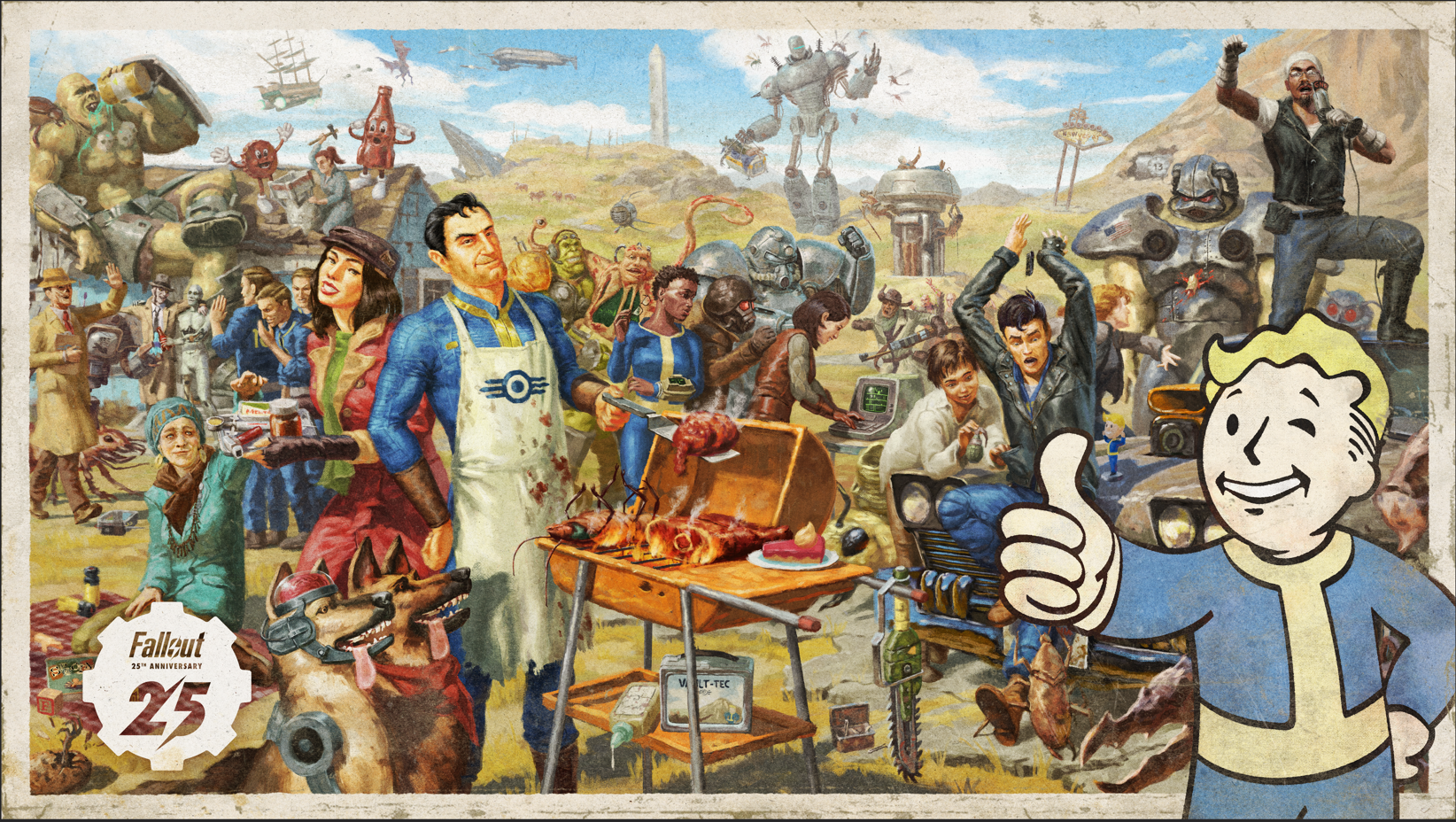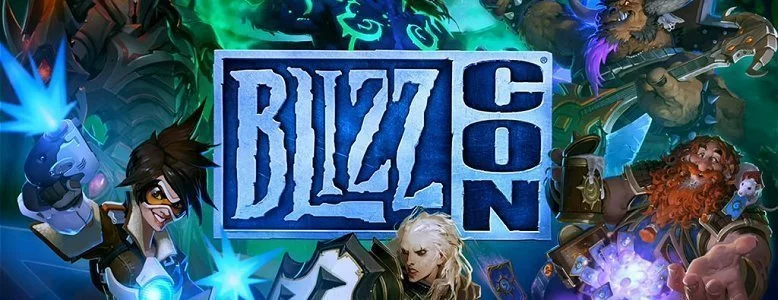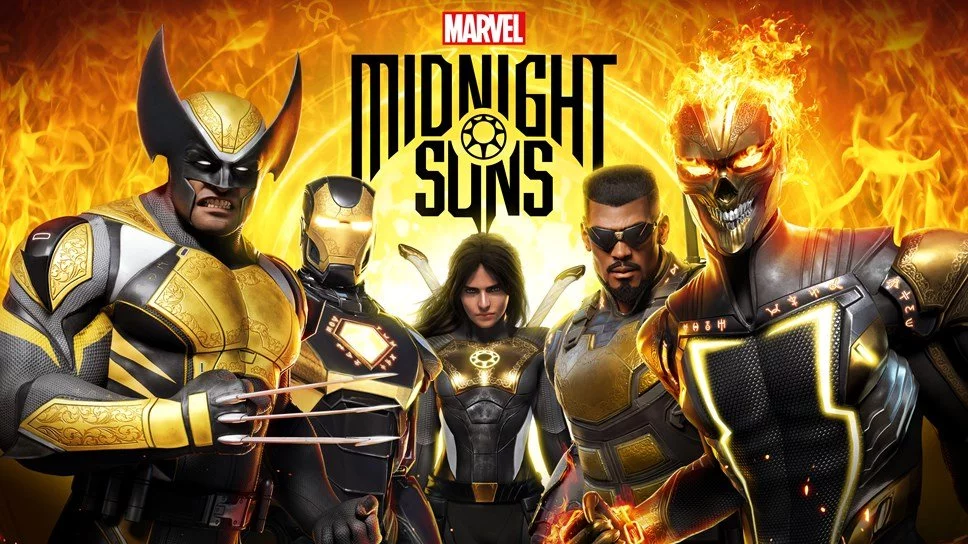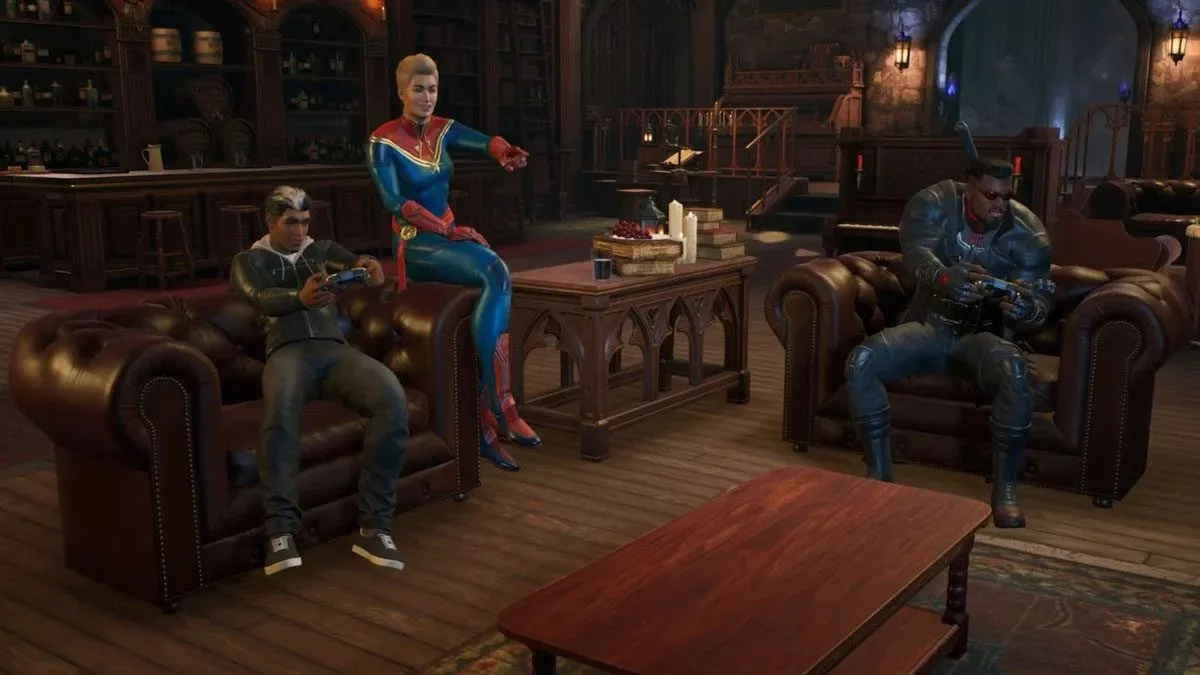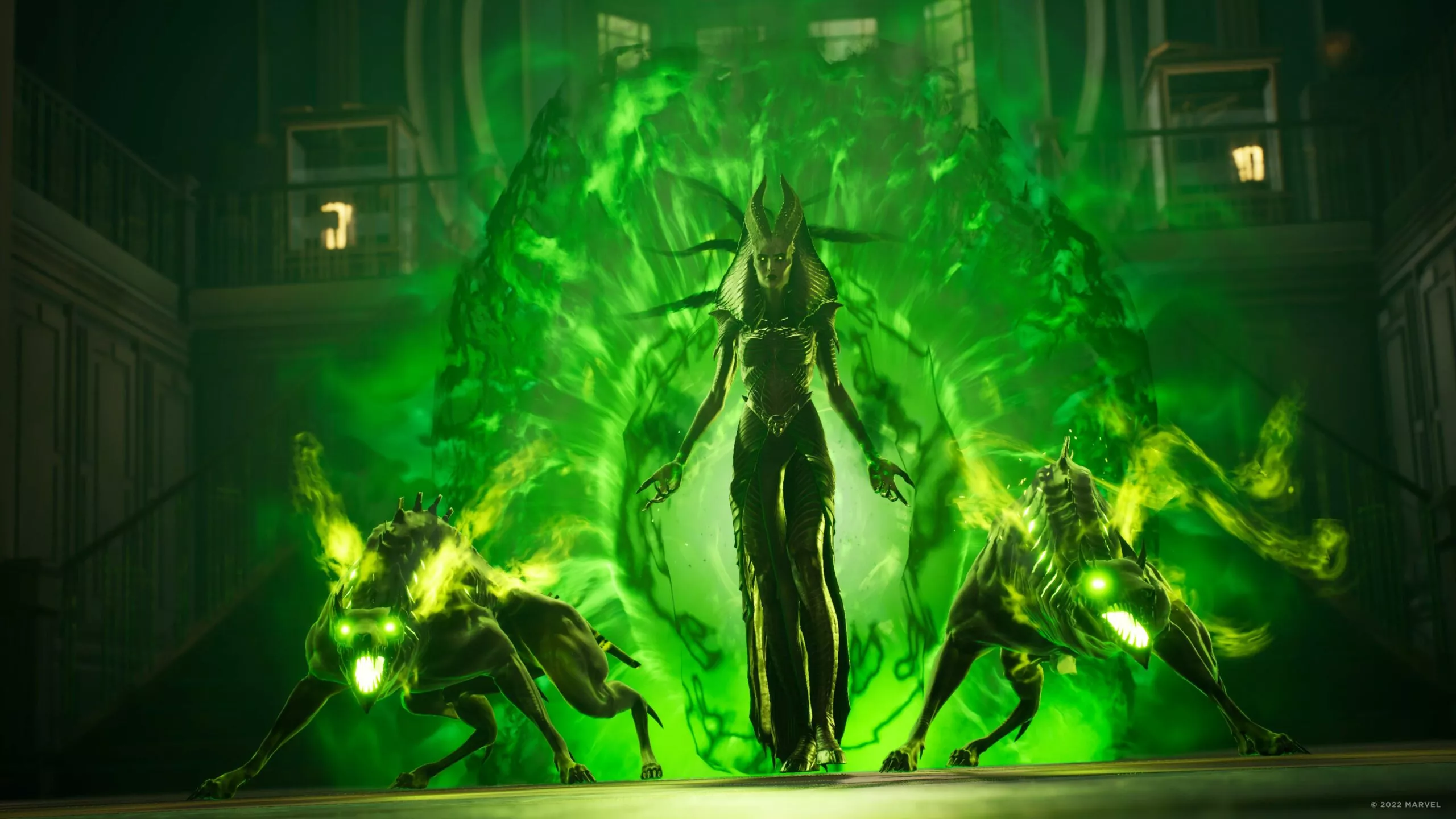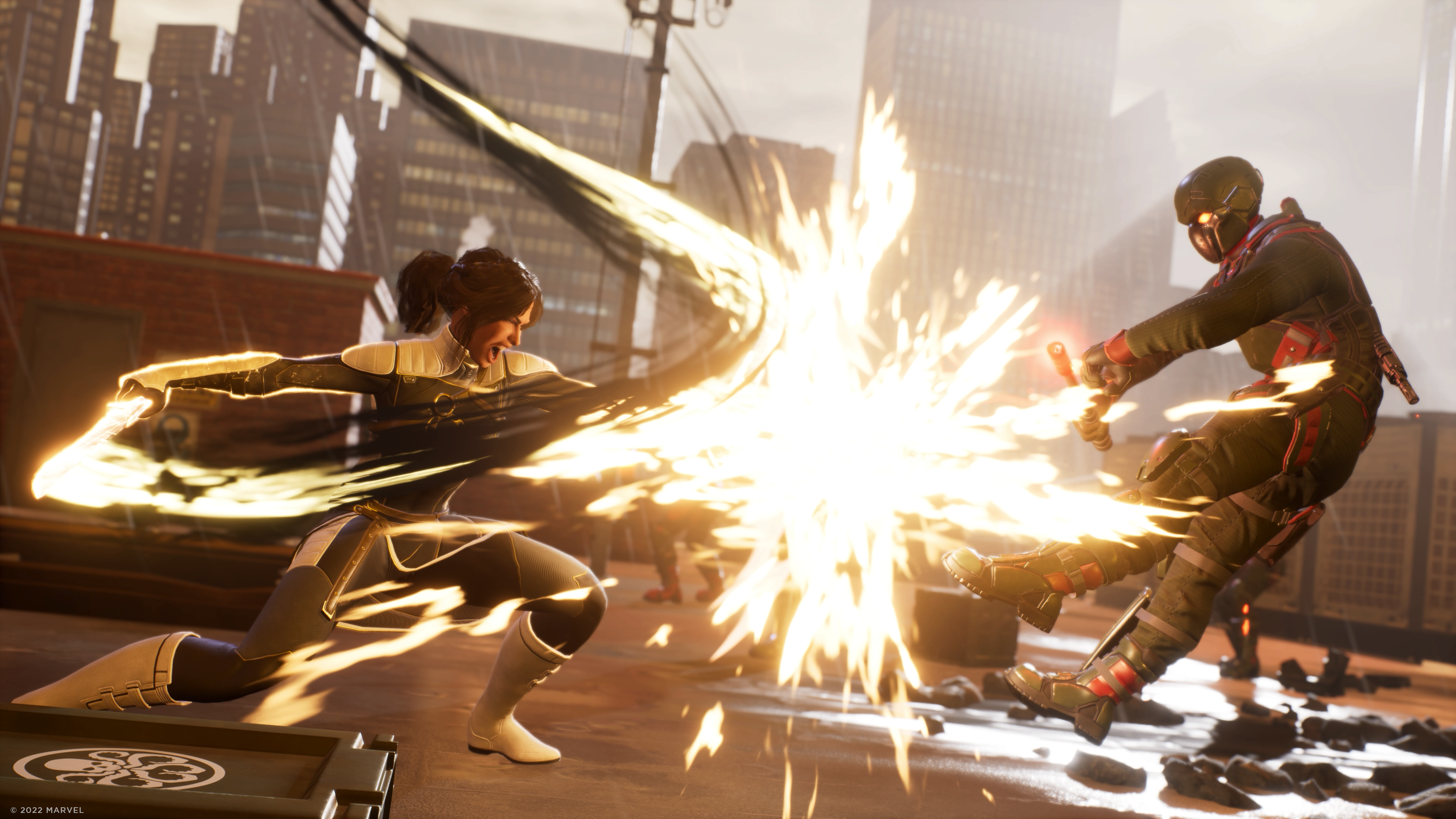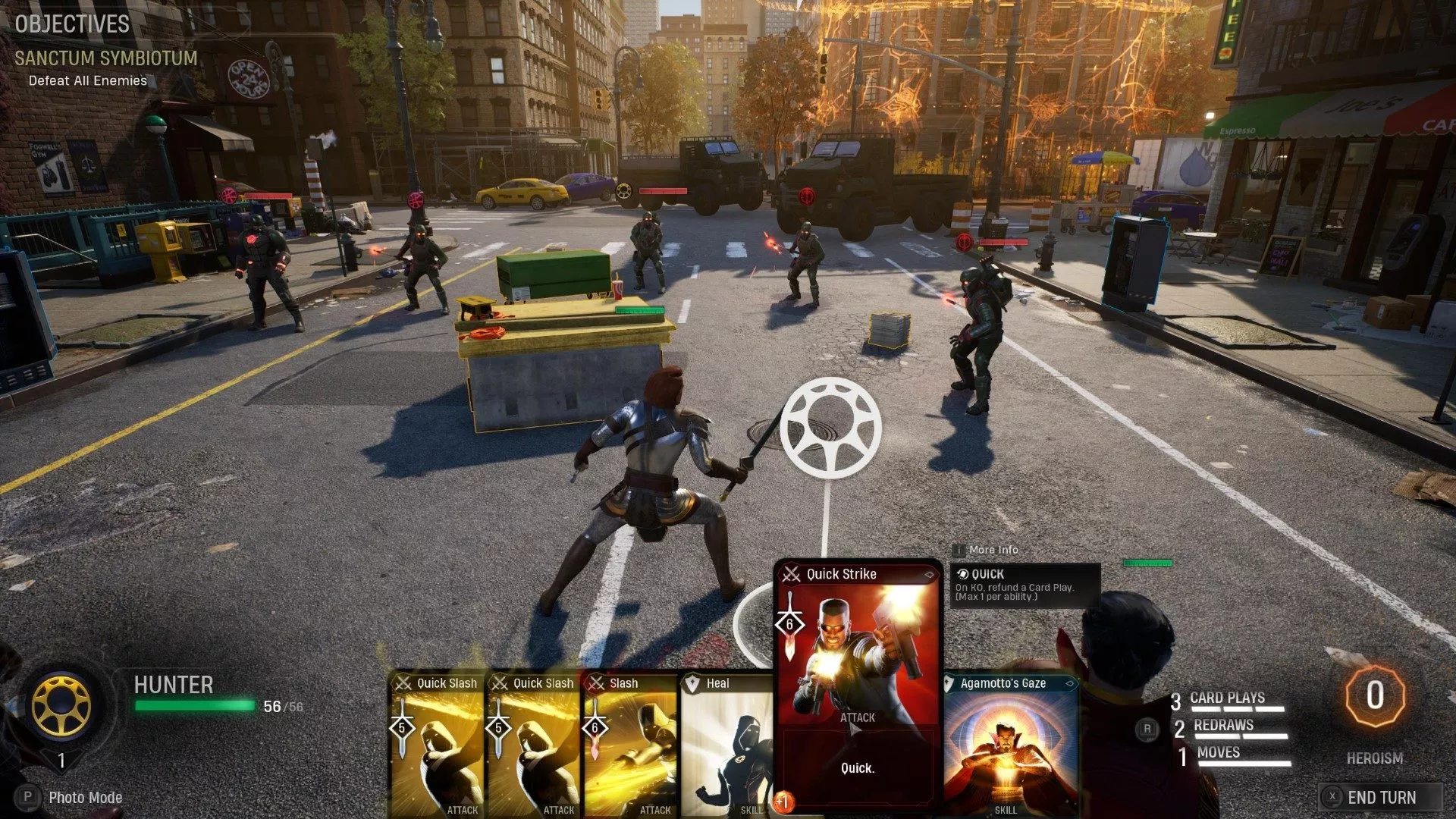Friends who fight demonic evil together, stay together
It’s no easy life, being a superhero. Alien invasions, baffling artefacts of unimaginable power, arcane magic, always needing to have an amusing quip on hand, it’s a lot.
Firaxis clearly wanted to make its game of stepping into the shoes of a superhero as realistic as possible, because Marvel’s Midnight Suns is a LOT.
Wolverine is a big softy, once you get to know him
A typical review-style breakdown of the gameplay and features in Midnight Suns would qualify as a PHD dissertation in superhero strategy, so here’s the cliff notes. You’ll create a new hero in the Marvel universe — The Hunter — who will team with a dozen well- and lesser-known Marvel superheroes against the mother of demons, Lilith, and the forces of Hydra, because of course Hydra was going to ally with the queen of all evil. Your motley crew of Avengers, Runaways and X-Men are tasked with stopping the apocalypse through deck building, turn-based strategy combat, while your spare time is spent at the crew’s supernatural base of operations, The Abbey, training, upgrading, exploring and most importantly, making friends.
That’s right, Midnight Suns is half classic Firaxis turn-based strategy, half superhero friendship simulator. You’ll hang out with heroes, sitting by the pool, playing games or watching movies, exchanging gifts and getting to know their deepest secrets and harrowing backstories. Friendship is of course measured in bars and numbers, and as those bars fill up you and your hero friends become more and more powerful. Should social life or Wolverine in boardshorts become too much you can explore the vast Abbey grounds; uncovering mysteries, collecting resources and slowly earning abilities that open up new areas to pillage of secrets (as well as flowers and mushrooms).
Whilst combat is but a small part of the Midnight Suns experience, all friendships, flora gathering trips and book club discussions culminate in making you hit things harder. Said hitting occurs in turn-based card battles which have a familiar cadence; play weaker cards to earn resources that allow you to play stronger cards, combine powers for great effect and balance both the individual hero’s decks and your combination of heroes themselves to complement each other. The usual array of status effects, boons and banes are in effect here, if you have a passing familiarity with any deck building card game you’ll feel right at home.
Strategy comes from how you use the limited resources you have in battle and the myriad options the systems of Midnight Suns provide you. There are no surprises in combat, no percentage chances for success or undiscovered enemies. You’ll know who is on the board, what they can do and who they are attacking this turn, and it is up to you to eliminate the greatest threats and manage the rest as best you can. Heroes largely conform to traditional party roles: support, crowd control or damage dealer, making team balance important, at least in the early stages before you can bend the cards to your will with upgrades and mods. Most battles provide some small twist to the “beat everybody else up” theme; hack a terminal here, disable a vehicle there, but usually these boil down to taking something out quickly then using a precious card play (of which you get three on a standard turn) to hack/interrogate/plunder the objective.
Basic strategy begins with simple resource management and card combination, cast “weaken” before unloading your biggest attacks, build up heroism (your mana equivalent) this turn to unleash fury the next. As you earn new cards and then upgrade, combine and modify them, you’ll be able to better customise your heroes and build synergy between their abilities; the right decks can see you unleashing long chained attacks that grant you card redraws and extra moves when everything falls into place. The strategic well is most certainly deep in Midnight Suns, and the combat experience is satisfying.
The only punishment in the combat system is dealt out by the superheroes, this isn’t XCOM in terms of difficulty or need for dirty save-scumming to survive. It isn’t easy by any means, you’ll need at least some layer of strategic thinking to avoid being overwhelmed and especially to take out the Fallen, fellow superheroes under the influence of Lilith who pack a fair wallop. Those looking for tougher challenges can up the difficulty for greater rewards, and with the time investment the late game of Midnight Suns requires you may as well be getting a hard fight from it.
Who said the hero life is a lonely one?
There is a lot of Midnight Suns. I’m not just talking the 50-plus hour completion time, the huge roster of heroes to become besties with (of which you may only be able to reach maximum friendship level with three or four in any one playthrough) and the sprawling Abbey grounds to explore. I’m talking systems on systems with subsystems on the side, tutorials still popping 20 hours in, collectibles everywhere you look, sidequests and secrets, petting your dog (and cat!), and of course a main narrative with all the twists, turns and one liners you would expect from a Marvel property.
It is probably too much. You’ll wake up each morning in the Abbey and begin your rounds: sparring, a challenge zone to level characters up, opening your latest blindbox-alike for new cards, maybe analysing an artefact or intel cache for more resources. Send a hero on an ops mission for resource rewards, open some regenerating chests for cosmetic rewards, start a research project, craft some items, upgrade your cards and mod their abilities, if you’ve got the credits perhaps you unlock a room upgrade. Your superhero social media will be buzzing all the while, a friend will want to chat every other day, maybe you’ll get invited to a club meeting and maybe that club meeting needs you to provide some resources, so you’ll go foraging. That’s before you’ve even talked to anybody IRL, where you can dish out some compliments, help heroes by answering a question or going on a fetch quest, or progress one of the many story threads. After all of that is done, go and choose a combat mission for the day.
Story missions are sprinkled in among many optional, generic challenges, and you’ll be needing plenty of those optional missions to level up and earn the different resources needed to unlock research and upgrade abilities. At the least, you’ll be forced to do an optional mission in between each story progression. Story missions don’t radically change the mechanics too often, but usually involve some form of Fallen fight that ups the challenge. Midnight Suns has a bad case of “win the battle to lose the cutscene” going on, where victory in combat just triggers some kind of cutscene disaster where whoever (or whatever) you just beat to a pulp gets up and wrecks your day or starts the apocalypse. I never felt like what I was doing didn’t matter, but at some times what I was doing definitely did not matter beyond it being the requirement to keep the story moving.
Once you come home from a hard day’s work incapacitating Hydra’s forces you’ll get to hang out. Some nights it will be club night, where groups of like-minded heroes hang out and tinker with engines, read books, perform occult rituals or just generally progress the story and get to know one another. Other nights you’ll need to go on sidequests or missions, witchcraft can only happen at night you see. On the truly free nights you can hang out with heroes, building friendships with them, choosing activities and giving gifts based on how well you know them (some of these are quite clever, but you’ll also get some easy wins like giving the classic Spiderman comic to Peter Parker). Then you go to sleep and wake up to do it all over again the next day.
Most of it is interesting, especially the story threads that explore the witchcraft and dark magic at the core of The Hunter’s power. The historic witch hunts in the town of Salem are woven into the story, and while plenty of the supernatural elements of the Marvel universe bounce right off me, I was hunting journal pages and tracking down sidequests to get the full Midnight Suns story experience the whole way through. There is still a heap of prophecy this and dark lord that, but these tired themes are refreshed by their connection to strong, well developed and interesting characters. The greatest compliment I can give the story and characters of Midnight Suns is that it made me want to go searching out comics to get some more.
Unfortunately some of the daily grind is a chore, and it is the combined weight of it all that can drag Midnight Suns down from its high points. Watching Tony Stark force open your blind box of cards every morning drags, so does running over to Blade to combine and upgrade your new cards, then running to Captain Marvel to set up a new ops mission. The UI is mostly solid but it could certainly use some more shortcuts and snappier transitions for how long you spend in it. A few times I wished I had information like resource counts on hand and I did not, and it feels like there could be some fat trimmed from the whole “select a hero, check their deck” process before missions.
If you were called the Sorcerer Supreme, you’d be arrogant too
Living as a superhero though, that is pretty cool. As somebody to whom the MCU became completely unfollowable about halfway through the Avengers trilogy (I have to watch how many movies? AND a TV show?), my familiarity with the characters ranged from “who?” to “I don’t need a level five friendship to know why you hate your dad, Tony Stark”, and I really enjoyed getting to know the more obscure characters that make up the titular Midnight Suns; Magik, Nico Minoru, Ghost Rider and Blade. While this isn’t an MCU tie-in, the characters talk and act like the big screen heroes even if they don’t quite look like them. You can expect plenty of snappy dialogue, a lot of troubled upbringings and plenty of “boomer versus gen Y” drama between the Avengers and the young upstart Midnight Suns that does a good job of humanising these superhuman characters. The Hunter themselves has a complex backstory and long standing relationships with the major NPCs that drive the action, and some of the frustration at Midnight Suns is definitely that all the faffing about gets in the way of developing these characters and telling its main story.
While the presentation of Midnight Suns is solid, there are a few technical aspects that need to be addressed. The UX can get a bit messy, requiring you to run back and forth to trigger the interaction prompt for a character or object. While there is plenty of style to art design, you’ll have certainly seen more expressive faces in your trails and combat arenas and generic enemy designs are fairly bland. While there are no microtransactions in the review build, the blind box and limited resources structure would make them very easy to plug straight in, and even without exploitative monetisation the whole “random rewards in a box” thing is a bit on the nose thanks to years of bad actors across the industry. Load times on PC were a bit rough as well.
So who is Midnight Suns for? Those looking for a deep story experience in the Marvel universe are well served, provided they can also handle a complex deck building, turn-based strategy game. Those looking for a fun turn-based strategy game will find what they are looking for, provided they can cope with the heavy dose of Marvel flavour, a cumbersome system of card upgrades and movie nights with Captain America. The popularity of the MCU suggests few strategy fans will be put off by the wrapping, and as somebody who started his time in Midnight Suns Marvel-sceptical, rolling his eyes at the arrogance of Tony Stark and Doctor Strange and the generic angst of Blade and Magik, very soon these characters won me over with interesting stories, internal conflicts and motivations.
Midnight Suns is long and overloaded with systems (I didn’t even mention the light/dark faux-morality system, or new game plus, or levelling up your dog), but it is fun, both its combat and its superhero friendship simulation. The combat is good enough to keep you wanting more, and the story and character moments interesting enough that I didn’t mind how much they punctuated the flying fists and swinging swords. Making fighting alongside Wolverine as interesting as having a fireside chat with him is a tough ask, and Midnight Suns has nailed it.
Marvel’s Midnight Suns was reviewed on Windows PC via Steam, as provided by the publisher. Click here to learn more about Stevivor’s scoring scale.
This article may contain affiliate links, meaning we could earn a small commission if you click-through and make a purchase. Stevivor is an independent outlet and our journalism is in no way influenced by any advertiser or commercial initiative.


